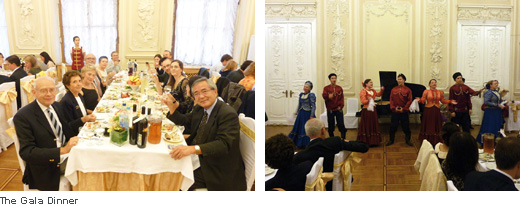|
|
MEETING REPORT
International Symposium on Advances in Synthetic and Medicinal Chemistry (ASMC St. Peterburg 11)
St. Petersburg, Russia, August 21-25, 2011
by Erden BANOGLU
The idea of bringing together the field of synthetic organic and medicinal chemistry in ASMC meeting series was frist created about eight years ago and started with Moscow meeting in 2004 with the aim bringing together the leading scientists and expert practitioners from academic, government and industrial institutions of eastern and western countries to power up the scientific potential which stayed apart for a long time. For these reasons, the locations of the meetings were decided to be chosen from the eastern countries and St. Petersburg was chosen for the second time to host this prestigious conference and to bring the participants together in a pleasurable social and cultural environment with high level of scientific presentations. Just to remind again, the ASMC meeting series were succesfully organized both by European Federation for Medicinal Chemistry (EFMC) and ChemBridge Corporation.

"The ASMC-St. Petersburg 11" was chaired by Prof. K. C. Nicolaou (University of California, US) and Dr. Antony Wood (Pfizer, US) to create a scientific environment to share arising trends in synthetic organic and medicinal chemistry in the area of biomedical research. The selected topics started from fundamental science and continued with presentations of applied scientific studies. With its distinguished panel of 39 renowned speakers and 192 peer reviewed poster presentations, the conference prosperously blended the acedemic life with industrial experience during the given presentations. Therefore, ASMC series continued the tradition with great success in advancing science of medicinal and synthetic organic chemistry and also successfully created a network of international audience of about 400 delegates from all over the world hence promoting cooperation between different institutions. This 4th meeting of the symposium series followed the tradition of previous three meetings and mainly included case histories of the recently developed clinical candidates and novel synthetic and catalytic methodologies in synthetic organic chemistry which could be useful for medicinal chemistry approaches for developing novel lead compounds. Therefore, as was in previous meetings, the main structure of the conference consisted of bringing together the synthetic organic and medicinal chemistry indicating that novel methodologies and advances in organic synthesis are of use for making biologically relevant molecules and have an important role to design medicinal chemistry approaches to be more efficient in the process of drug discovery. During the conference, the symposium chairmen and the members of organizing committee have done a great job to organize each session in a heterogeneous way to blend speakers from academia with pharmaceutical industry with particular care on didactic aspects of the symposium.
Over four days, the participants attended an elegantly organized program, which covered drug discovery advances in some major therapeutic areas, as well as the recent advances in synthetic methodologies and optimization strategies which may be useful in drug design and development studies. Each presentation emphasized on first time disclosures, emerging drugs/targets and emerging synthetic technologies.

The symposium started with Prof. Nicolaou's talk on the natural product Maitotoxin which is an extremely potent toxin produced by Gambierdiscus toxicus to present the recent advances and current status as an inspiration for research in chemistry and biology. Morning talks also included novel synthetic approaches for enantioselective functionalization of C-H bonds to develop green and efficient synthesis of heterocycles and other biologically relevant motifs. Harmonized with these talks also the medicinal chemistry approaches had its place with case histories of the discovery of tofacitinib (CP-690,550), a potent and selective JAK inhinbitor and TMC435, a novel macrocyclic hepatitis C virus protease inhibitor. The story behind the discovery of GPR119 for the treatment of type 2 diabetes was also one of the interesting presentations of the first day in the symposium. The second day mostly emphasized on the changing face of complex, time consuming and expensive drug discovery process indicating the place of novel approaches such as chemical biology and epigenetics, with a focus on identifying novel molecular targets and new molecules to support the construction of an enhanced and robust drug discovery pipeline. In addition, presentations regarding synthetic organic chemistry, i.e., chiral synthesis, synthesis of novel conformationally rigid diamines, a new catalytic system for C-H activation, synthesis of bicyclic peptide systems, novel synthetic approaches in the preparation of pharmaceutically important heterocycles and their relevant biological potentials, were successfully organized as a part of each session. Third day of the symposium was started with focusing on the role of bioactive natural products in the drug discovery. Chemical biology of the natural product cyclopamine as an inhibitor of hedgehog signaling and novel synthetic methodologies for total synthesis of polyphenol-based natural products were the interesting and scientifically rich presentations along with development of novel azetidine urea derivatives as fatty acid amide hydrolase inhibitor VER-158416. Another new finding on the importance of halogen bonding in protein-ligand interaction and binding affinity was also succesfully discussed during presentations. Last day of the symposium also concentrated on the synthetic new methodologies on asymmetric synthesis of bioactive molecules such as MFPA and chaetocin and their relevant biological properties. Again C-H activation reactions and metal-catalyzed C-H bond functionalizations for use in medicinal chemistry were the continuation of first talks in this topic and overall the importance of C-H bond activations in the synthesis of novel chemotypes and for providing a utility to develop novel drug-like molecules were clearly dealth with during the symposium. Along with the synthetic chemistry presentations, the stories on the validation of N-myristoyltransferase as a new therapeutic target, development of mGluR4 positive allosteric modulators for Parkinson's disease, oncologic drug development efforts targeting Wnt/β-catenin pathway, use of natural product grandisine alkaloids as δ-opioid receptor antagonists and discovery of novel antimalarial chemotypes were very exciting in a way that although the use of modern approaches have widely been utilized to identify and understand the structural interactions of lead compounds for clinical development, the use of conventional and novel chemical strategies were the main driven force for the success of each story.
Once more, the ASMC meeting series successfully enlightened the close connection between synthetic organic and medicinal chemistry and carried a message that changing face of organic synthesis for making biologically important molecules has a pivotal role using medicinal chemistry approaches more efficiently in drug discovery process.

|
|

Editor
Gabriele Costantino
Univ. of Parma, IT
Editorial Committee
Erden Banoglu
Gazi Univ., TR
Lucija Peterlin Masic
Univ. of Ljubljana, SLO
Leonardo Scapozza
Univ. of Geneve, CH
Wolfgang Sippl
Univ. Halle-Wittenberg, DE
Sarah Skerratt
Pfizer, Sandwich, UK

Executive Committee
Hans-Ulrich Stilz President
Gerhard F. Ecker Past Pres.
Koen Augustyns Secretary
Rasmus P. Clausen Treasurer
Hein Coolen Member
Gabriele Costantino Member
Phil Jones Member

|









